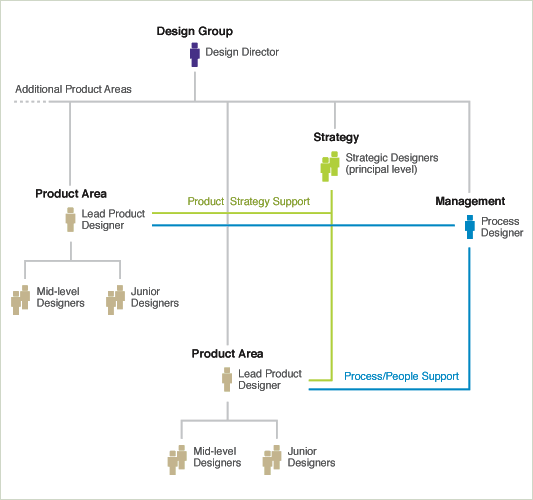It’s hard to work in a large design team without getting at least somewhat involved in how the group is organized. During my time within such teams, I’ve been a part of many discussions and iterations of different organization models.
From these experiences, I’ve developed a model that seems to be able to sustain a large amount of distinct project work and simultaneously support the diversity of the designers within the team.
The model is under laid by the fact that in addition to different skill-levels, designers also have unique strengths and interests in particular types of design work. In particular: product design, strategic design, and design management.

Some designers are tremendously adept at visualizing a complete product experience and how it maps to business and user goals. These designers are invaluable during the early stages of product ideation. They help focus product strategy and give teams a vision to drive toward. Strategic designers, however, are not content to focus on a single product area. They thrive when given diverse large-scale challenges. For these reasons and more strategic designers in this model are shared resources: they work with teams to conceptualize goals and product directions then reduce their involvement during the development phase of a project.
Other designers excel in the ability to get recurring product updates (that drive toward a long-term goal) out the door quickly and efficiently. They have a passion for a particular product and quickly become domain experts in that product area. When coupled with a senior-level skill set, these designers make great product leads. They manage the ongoing design roadmap and work with mid to junior level designers to continually improve the products under their purview.
Frequently both strategic designers and product leads are not interested in the day-to-day management of teams. They either have a passion for a specific product area or for high-level systems thinking. For them, a management position is both uninteresting and unrewarding. At the same time, people and process management needs to occur to keep things running smoothly. Unfortunately, most design organizations only offer management paths for career growth.
Luckily, there are designers that enjoy managing processes and people. In this model, a process designer supports product leads and the Design Director by providing process management, knowledge sharing, and human resources functions for the group. This keeps the product leads from being burdened by focal reviews, hiring paperwork, and more.
The Process Designer, Lead Product Designers, and Strategic Designers all report to the Design Director who is responsible for the well being and external representation of the entire group.